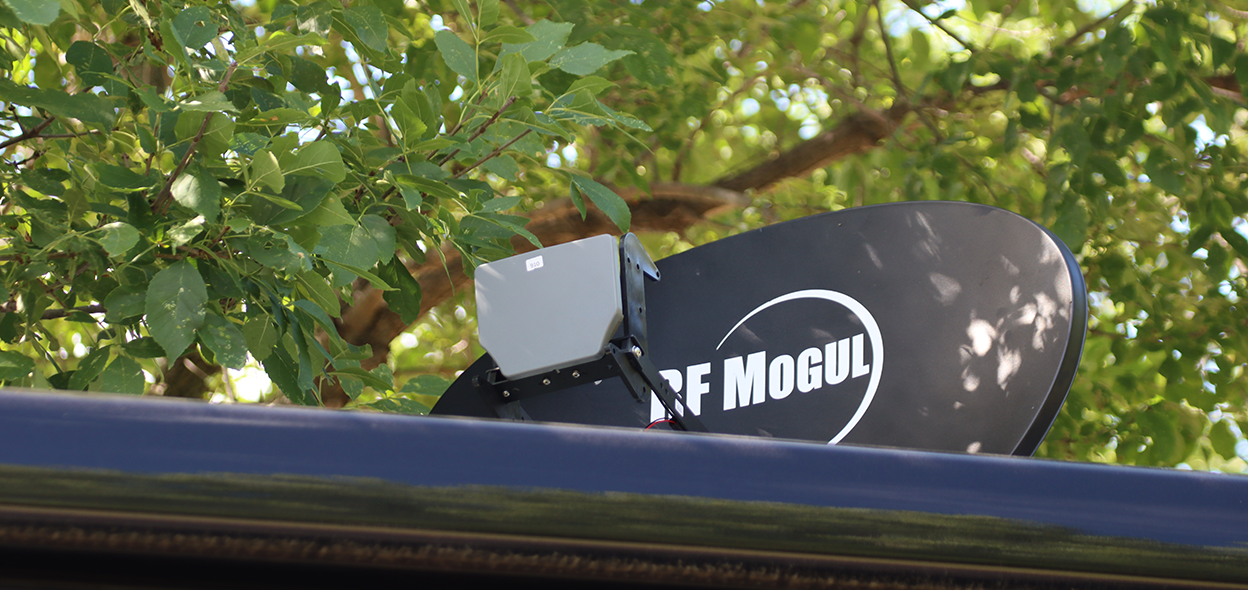Most every motorhome is equipped with some sort of satellite TV. Satellite TV has its pros and cons but for an RV owner who is mobile, satellite TV is often a good choice as long as you can get a clear view of the southern sky that is not encumbered by trees or other obstructions. Oftentimes it’s not possible to get a strong internet signal when you are camped in an area where there is minimal, if any, cellular signal and the loss of that precludes streaming live TV or movies. The majority of campground Wi-Fi networks are not capable of handling the bandwidth and many have imposed limits on usage and don’t allow streaming. Combine that with the high cost of unlimited bandwidth cellular plans and it can make satellite TV a valid option for some RV owners at this point in time. Technology is constantly changing and ventures like StarLink may be an alternative, depending on how it is priced, but for right now satellite TV still has a place in the RV industry.
Satellite TV is typically serviced by either DirecTV or DISH Network, although services such as Shaw TV are available in Canada. Of course you can’t have satellite TV unless you have a satellite receiver and satellite dish, which serves as the antenna to receive the signal from the satellite. Most RV owners that are not full-timers simply take the receiver or DVR from their house and put it in the RV when they travel but satellite dishes are available in a number of different versions. Small compact portable units are available from manufacturers such as Winegard, King Controls and DISH network that can automatically locate and lock onto the satellite signal as are tripod based units that require a bit of setup time and will need to be manually aligned to the satellite. Automatic dishes, such as the Winegard Trav’ler, are also available that mount to the roof of a motorhome and can be operated by a remote control box located within the RV. These units will deploy and lock onto the satellite automatically at the push of a button as long as you aren’t parked in a spot where tree limbs can block the signal. When it’s time to break camp these units will automatically store themselves when you press the appropriate button on the control box.
Our coach came with a factory installed automatic dish mounted on its roof. When this unit failed, I found that it was not field serviceable. It could be sent back to the factory for refurbishment but, after searching on some RV forums, I found that this can take quite a bit of time before I would even receive an estimate of the repair costs, assuming the unit was even repairable. I also found numerous recommendations for the Eagle satellite dish by RF Mogul as being a better choice so I decided to go with the RF Mogul dish. I found that the RF Mogul dish was field serviceable and numerous owners gave glowing reviews about the product and customer support. It was also easy to convert between DISH network and DirecTV, Shaw or Bell. All it takes is a swap of the LNB arm and a software update so if I decide to change satellite service providers in the future it’s not a big deal. With all these positives, I decided it was time to replace my original satellite dish and go with the RF Mogul.
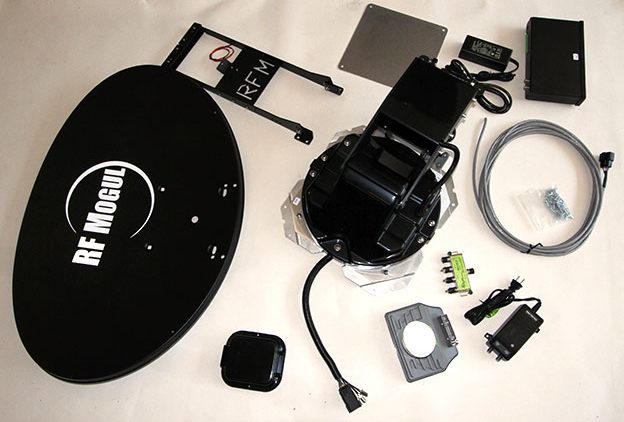
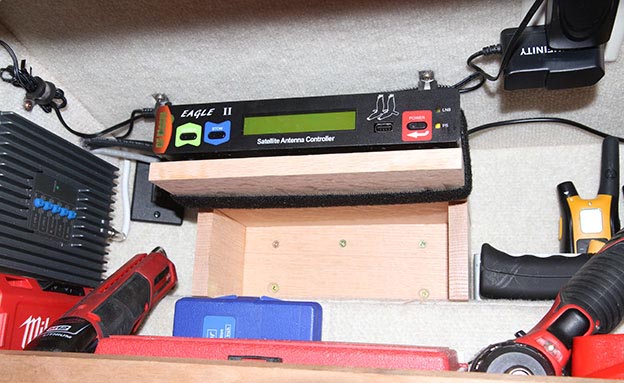
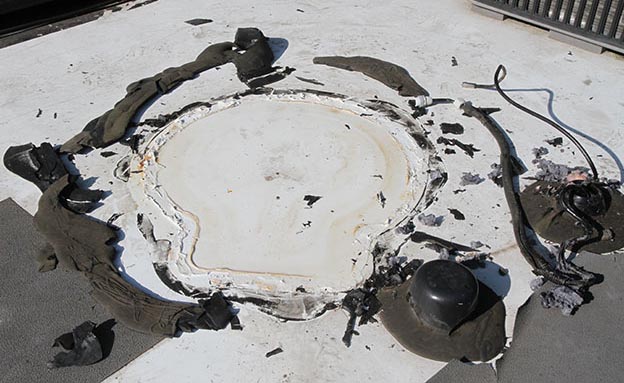
Installation Considerations:
The RF Mogul is a bit more sophisticated than my original dish. It relocates the electronics from the rooftop unit to the controller box inside the coach. This shields it from excessive rooftop heat and any potential moisture penetration, making it more reliable. This also meant that my original 8 conductor cable needed to be replaced with RF Mogul’s 12 conductor cable to allow communication from the controller to the dish motors and other components in the satellite dish. Another consideration was that the original dish had one coaxial cable that handled the signal from the satellite. It ran from the dish directly to a coaxial 1×4 splitter in the coach basement so that the signal could be distributed to the four TVs in the coach. The RF Mogul runs a cable from the dish to the controller and the controller then uses a second cable to output the signal to the 1×4 splitter to feed the TVs so a bit of coax rerouting would be required.
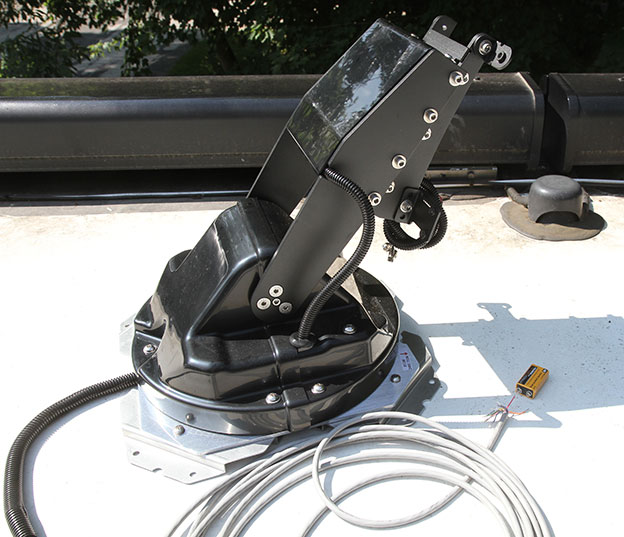
The DISH itself ways 53 lbs.so it can be fairly heavy to lug up a ladder. Obviously not a concern if you have it installed by a certified RF Mogul dealer, such as National Indoor RV Centers but a bit on the heavy side for a one man do-it-yourself installation. I first removed the original dish and threw it off the roof, then proceeded to scrape off all of the old sealant and clean up the roof. Once I had a nice clean roof I fiberglassed up the old screw holes used to mount the dish to the roof to seal them up and make way for fiber glassed the new mounting pattern of the RF Mogul. I then brought the main turret of the RF Mogul up to the roof with a rope and ladder and prepared to assemble the unit. Next I installed the arm, the reflector dish and the LNB to the turret, following the excellent instructions provided. I did have one question and gave them a call and left a voice mail message because it was a fiber glassed Saturday. Within 15 minutes I received a return call and my question was answered, which was something I would never get from the manufacturer of my previous dish. The RF Mogul also has the capability of being illuminated by LED lighting. The wires are in place and you do need to connect them on the backside of the dish if you want an illuminated dish so I decided to connect them up and position the assembly on the roof and used screws to fasten the assembly to the roof.
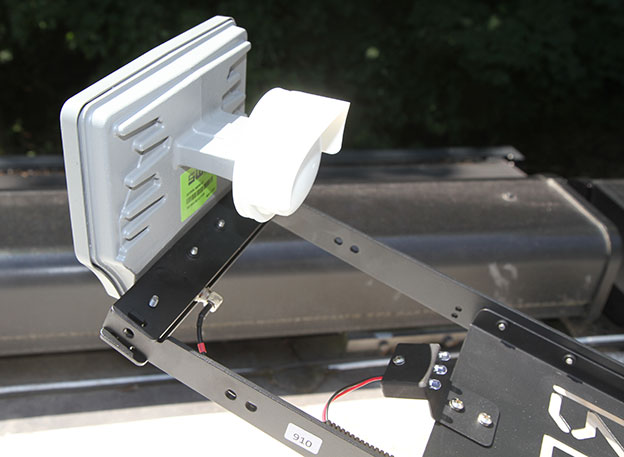
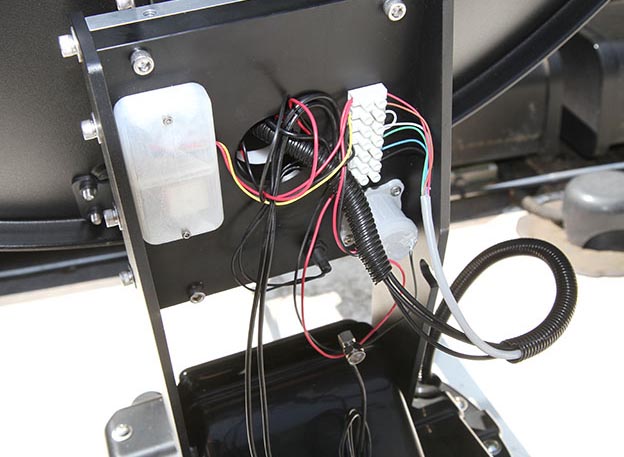
Once the dish was in place I ran the wires into the coach. When stowed the RF Mogul only took up 37” of roof space whereas my original dish required 44” when stowed so that gave me a bit more room to locate the RF Mogul unit. The joints in my original dish were fairly sloppy and that allowed the hard roller on the dish to wear a groove into the fiberglass roof material which I had repaired with a piece of 3M SafetyWalk vinyl material to prevent wearing through the fiberglass. But the RF Mogul came with a nice set of skids to support the arm as well as a stainless steel plate for it to rest on so I removed the vinyl material, cleaned up the adhesive and replaced it with the stainless steel plate.
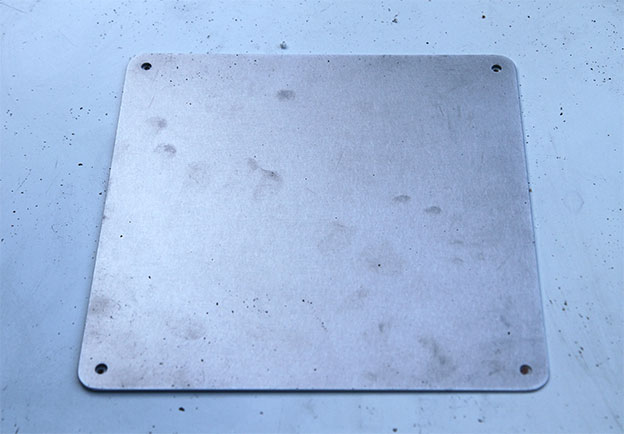
The controller for the original satellite dish was installed in an entertainment center cabinet that was located in a slideout. It wouldn’t be practical to replace its 8-pin communications cable with the RF Mogul’s 12-pin cable, plus run the new coax from the dish to the cabinet due to the minimal size of the wire chase in the slideout mechanism. Instead, the new controller was installed in an overhead cockpit compartment on the driver’s side where it was easy to run the new cables between the dish and controller. All of the cable entrances, as well as any rooftop fasteners, were sealed up with sealant to prevent any leaks. The coax cable leaving the controller then ran down to the satellite TV distribution splitter and power inserter in the basement, where it fed all of the satellite receivers in the coach. After making the required connections to the controller the system was ready for testing.
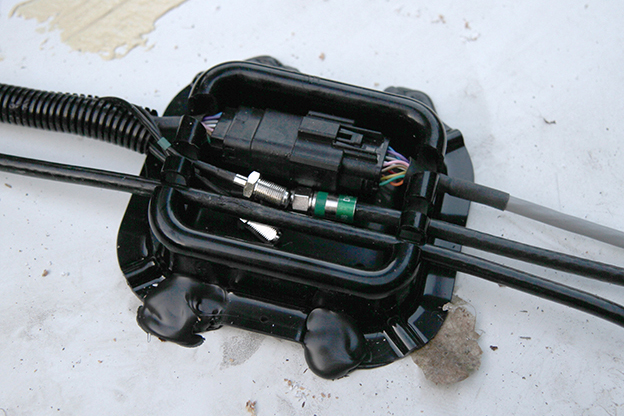
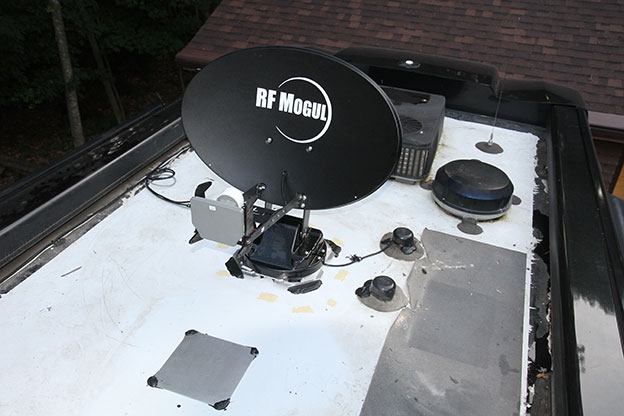
Testing:
When the RF Mogul was installed it was plain to see that this unit was constructed better than the original satellite dish that was installed on the coach. When the arm was raised it was rock solid and wasn’t as sloppy as the original dish. I couldn’t test the system immediately after installation due to heavy tree coverage but we were scheduled to leave on a long trip shortly after completing the installation so my testing was reserved for our first night on the road. I pulled into the campground and switched on the system. I performed the initial synchronization procedure to marry the controller to the dish, as stated in the manual, then pushed the Search button and waited. I walked outside as the dish quickly found its GPS location and raised and rotated the dish to find the satellite. To my dismay, there was a tree branch overhanging our coach with brush partially obscuring the dish so I didn’t’ expect to get a signal. But, to my surprise, when I went inside the coach I found that the TVs were working anyway. I didn’t expect that, based on past experience.
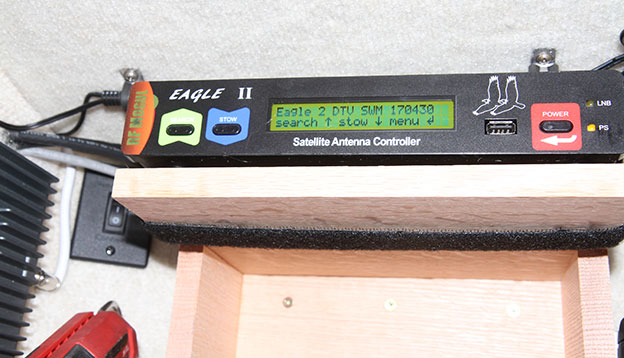
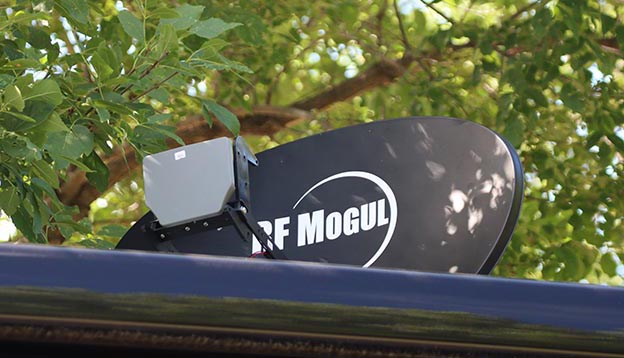
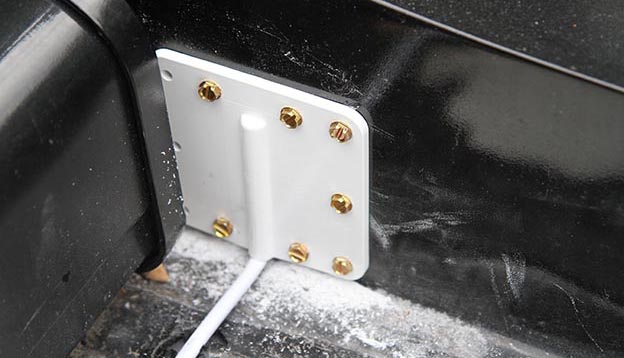
We had a number of overnight stops during this trip and I was very impressed with how rapidly the RF Mogul would lock onto the satellite. Both the raise and stow procedures were much faster. The GPS built into this unit really makes a difference. Our old dish would rise up and rotate, trying to find the satellite, then continue on in steps until it finally found it. The GPS on the RF Mogul tells it just where to look so it goes right to that area, then peaks the signal. It also locks in with a stronger signal. All satellite dishes will encounter rain fade when the rain clouds start to darken the sky. But the RF Mogul gave us much more signal strength and we retained good reception until the rain came down much heavier. With our previous dish we would have been out of service much earlier. I didn’t think there would be any difference because the dish and LNB are the same as what is used on most every dish setup out there but the proof is in the results.
Further research revealed that the signal improvement was mainly due to three factors. The tighter tolerances of the mechanism allow for very accurate aiming without any freeplay or movement by the wind. If you grab hold of the unit while it is extended you can’t feel any movement in the elevation, azimuth or skew. The tighter tolerances of the steel gears used in the RF Mogul give it a closer lock on the satellite whereas the cast steel and nylon gears of my previous unit had quite a bit of play which allowed for signal drift, especially in windy conditions. The GPS also adds a bit more accuracy, working in combination with some sophisticated algorithms to allow for extremely accurate peaking that yields the strongest possible signal.
My final test was at a campground in Wyoming. We stay at this campground frequently on our trips out west and always get our same favorite spot. But many years ago we lost the ability to use our satellite dish because the huge oak trees just kept growing and blocking the dish’s view of the southern sky. This wasn’t specific to any one RV either because all four of our motorhomes had the same issue at this spot. We just gave up on satellite TV in that location due to the large overhanging branches. But just for kicks I figured I try it with the new RF Mogul dish. The system took a bit longer to lock on but it actually did find the satellite. I actually had satellite TV inside the coach! My DirecTV system had a triple LNB dish so some of the channels reverted to standard definition because the outer LNBs couldn‘t see through some of the heavy limbs. But we were still able to watch our channels, which was amazing for this location. Given the overall quality and performance of this unit, plus excellent support from both RF Mogul and an installing dealer such as National Indoor RV Centers I have to rate this amazing satellite dish a full five stars.


